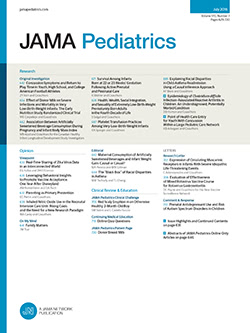Role of Sleep and White Matter in the Link Between Screen Time and Depression in Childhood and Early Adolescence
IF 18
1区 医学
Q1 PEDIATRICS
引用次数: 0
Abstract
ImportanceWith the widespread adoption of screen-based devices among adolescents, there is growing concern that more screen time could contribute to mental health problems such as depression. It is thus critical to identify potential mediating factors that could help explain this potential risk relationship. Recent evidence indicates that more screen time could impact sleep duration and brain structural connectivity (ie, white matter organization), which are critical for emotional health. Notably, sleep duration is a modifiable behavior that health care providers can easily target.ObjectiveTo identify the association between screen time during late childhood and depressive symptoms in early adolescence, and to investigate whether these associations are mediated by sleep duration and white matter organization.Design, Setting, and ParticipantsThis prospective study was conducted from January 2024 to June 2024. Data from the Adolescent Behavior Cognitive Development (ABCD) Study were used to identify clinical and neuroimaging characteristics of participants at late childhood (T1; defined as aged 9-10 years) and early adolescence (T2; defined as age 11-13 years). Children and their parent/caregiver were recruited across 21 US cities. Participants with no past/current psychiatric disorders at T1 were selected for analyses. Initial analyses were conducted in 2024 and finalized in February 2025.Main Outcomes and MeasureOutcomes included screen time assessed using a self-report questionnaire, sleep duration assessed using the Munich Chronotype Questionnaire, and depressive symptoms characterized using the Child Behavior Checklist. Neurite orientation dispersion and density imaging and a tract profile approach were used to characterize the orientation dispersion index of 3 white matter tracts that are known to be implicated with depression: cingulum bundle, forceps minor, and uncinate fasciculus.ResultsAnalyses included 976 participants (460 children [47.1%] were female, mean [SD] age was 9.9 [0.6] years at T1 and 11.9 [0.6] years at T2). Each additional hour of daily screen time at T1 was associated with a 0.12-point (95% CI, 0.04-0.20;睡眠和白质在儿童和青少年早期屏幕时间与抑郁之间的关系中的作用
随着屏幕设备在青少年中的广泛采用,越来越多的人担心屏幕时间过长可能会导致抑郁症等心理健康问题。因此,确定可能有助于解释这种潜在风险关系的潜在中介因素至关重要。最近的证据表明,长时间看屏幕可能会影响睡眠时间和大脑结构连接(即白质组织),这对情绪健康至关重要。值得注意的是,睡眠时间是一种可改变的行为,医疗保健提供者可以很容易地将其作为目标。目的探讨儿童后期屏幕时间与青少年早期抑郁症状之间的关系,并探讨睡眠时间和白质组织是否介导了这种关系。设计、环境和参与者本前瞻性研究于2024年1月至2024年6月进行。来自青少年行为认知发展(ABCD)研究的数据用于确定参与者在儿童期晚期的临床和神经影像学特征(T1;定义为9-10岁)和青春期早期(T2;定义为11-13岁)。在美国21个城市招募了儿童及其父母/照顾者。在T1时没有过去/现在精神疾病的参与者被选中进行分析。初步分析于2024年进行,并于2025年2月完成。主要结果和测量结果包括使用自我报告问卷评估屏幕时间,使用慕尼黑睡眠类型问卷评估睡眠时间,以及使用儿童行为检查表描述抑郁症状。神经突定向弥散度和密度成像以及神经束剖面方法被用于表征已知与抑郁有关的3个白质束的定向弥散指数:扣带束、小束和钩侧束。结果共纳入976名参与者,其中460名儿童(47.1%)为女性,T1时平均[SD]年龄为9.9[0.6]岁,T2时平均[SD]年龄为11.9[0.6]岁。T1时每天屏幕时间每增加1小时与0.12点相关(95% CI, 0.04-0.20;P = 0.008),儿童行为检查表抑郁评分增高。更短的睡眠时间和更差的带束组织(更大的取向弥散指数)在T2介导36.4% (95% CI, 18.2%-63.6%)的屏幕时间与更多抑郁症状之间的关联。结论和相关性本研究的结果表明,童年后期屏幕时间越长,抑郁症状越多,这可能是由于青春期早期睡眠时间越短,白质组织越差。这些发现强调了促进健康习惯和平衡屏幕时间与充足睡眠的重要性。
本文章由计算机程序翻译,如有差异,请以英文原文为准。
求助全文
约1分钟内获得全文
求助全文
来源期刊

JAMA Pediatrics
PEDIATRICS-
CiteScore
31.60
自引率
1.90%
发文量
357
期刊介绍:
JAMA Pediatrics, the oldest continuously published pediatric journal in the US since 1911, is an international peer-reviewed publication and a part of the JAMA Network. Published weekly online and in 12 issues annually, it garners over 8.4 million article views and downloads yearly. All research articles become freely accessible online after 12 months without any author fees, and through the WHO's HINARI program, the online version is accessible to institutions in developing countries.
With a focus on advancing the health of infants, children, and adolescents, JAMA Pediatrics serves as a platform for discussing crucial issues and policies in child and adolescent health care. Leveraging the latest technology, it ensures timely access to information for its readers worldwide.
 求助内容:
求助内容: 应助结果提醒方式:
应助结果提醒方式:


